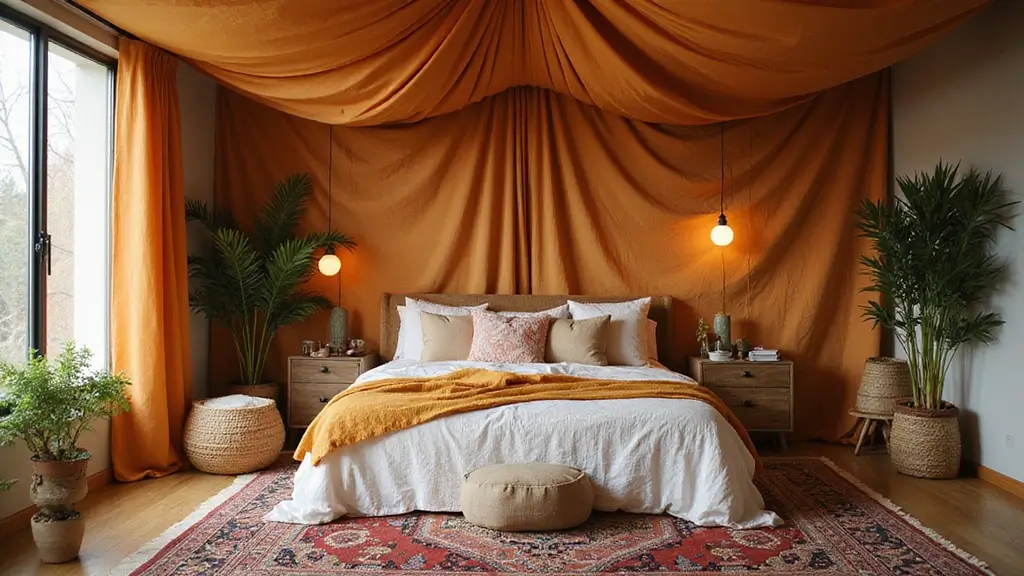Your bedroom ceiling is the part you see most at night and forget during the day. A fabric ceiling can soften the light, soften the space, and add texture you can feel. If a flat white ceiling makes the room feel small, fabric can open it up with drama without a big remodel.
Here is why I made this post. Why I made this post is simple: I want bedrooms that feel alive, not flat. This season has me craving cozy, dramatic ceilings. I pulled together 30 fabric ceiling ideas for bedrooms that add texture and drama so you can pick a look you actually use.
Who it’s for is easy to tell: if you love a room that feels soft to the touch, if you want texture that does not require heavy work, or if you rent and cannot paint, this post is for you. You care about comfort, light, and a space that helps you unwind.
What you’ll get is a guide you can actually use. A gallery of ideas that run from velvet drama to linen calm. You’ll learn what materials work, how they feel in real life, and quick steps to try them. Expect practical tips you can copy right away, plus ideas that fit different budgets and lighting.
Each idea is described with simple steps: what you need, how to install, and what to watch for. Start with a small swatch or a single panel to test the vibe. Use easy methods like ceiling clips, frames, or adhesive strips that suit renters. I also point out care tips for fabrics so your ceiling stays fresh.
Not every idea suits every ceiling. Tall, dark rooms can handle heavy fabrics; low ceilings shine with lighter textures. If you try one, tell me how it changes your room. Ready to add texture and drama to your bedroom ceiling? Let’s pick a look and start.
1. Dreamy Canopy Drapes
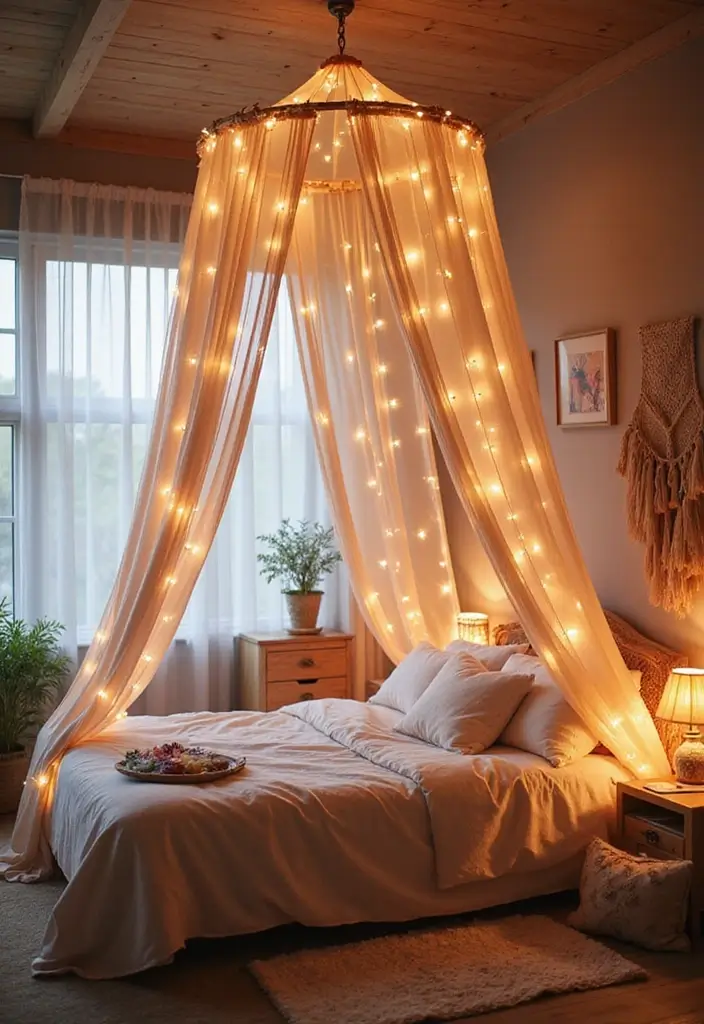
Dreamy Canopy Drapes
You want a bedroom that feels private and calm. Canopy drapes from the ceiling give you that look. They wrap your bed in soft fabric and set a retreat mood. As a fabric ceiling idea, they turn the ceiling into a soft focal point.
Here is why they work. Sheer fabrics like organza or chiffon stay light. They let air move, so the room stays open. Layering colors or patterns adds texture without heavy walls.
Let’s break it down. How to pick fabric: choose sheer materials that fit your mood. White for airiness, beige for warmth, pale blue for calm. For a boho touch, mix whites with a soft print.
How to hang them: install a simple curtain rod near the ceiling. A thin tension wire works for a clean, minimal line. Let the fabric fall naturally; a slight touch on the floor adds drama.
Color and layout: keep the canopy in light tones so it blends with the ceiling and walls. If you want contrast, pick one soft accent color for bedding.
Finish touches: weave fairy lights through the layers for a gentle glow after dark.
2. Bold Fabric Panels
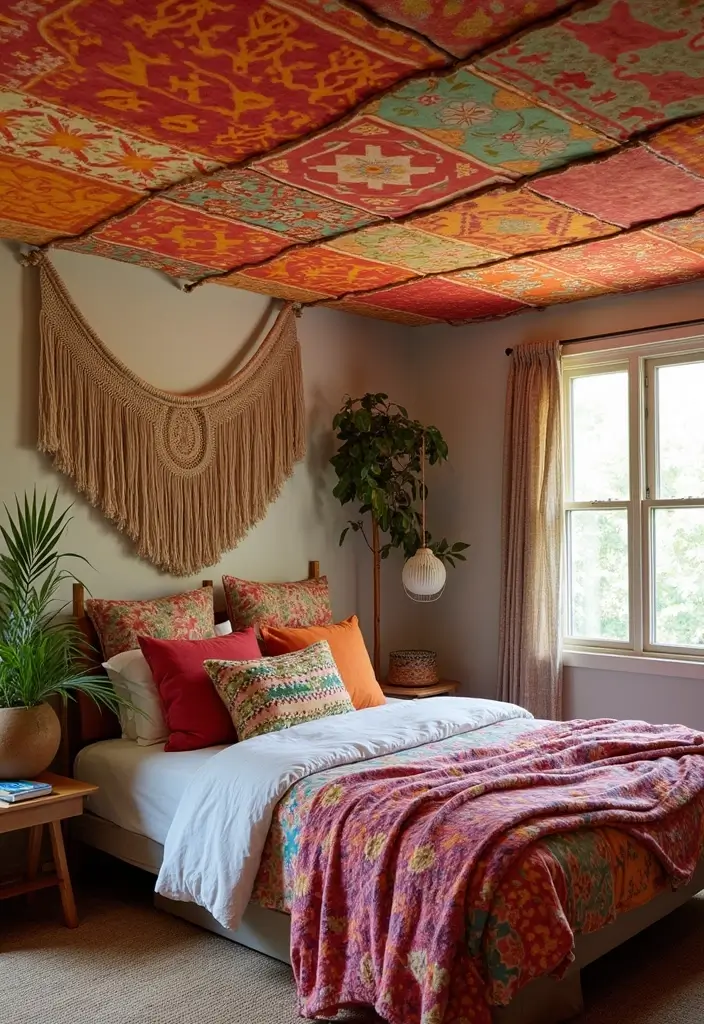
Want a ceiling that adds texture and drama without heavy paint? Bold fabric panels can do it. They pull your eye upward and can make a small room feel taller. You can pick bright colors or big prints to match a boho or modern vibe. This method is flexible and easy to adjust as trends shift. Here is why it works.
– Fabric choices: Choose oversized patterns and rich textures to anchor the ceiling and set the mood.
– Installation basics: Cut the fabric to fit the ceiling area, then attach it tight with adhesive or a staple gun, pulling evenly so no wrinkles show.
– Mix and match: Alternate different patterns so the ceiling reads as layered texture, using a shared color base.
– Lighting and texture: Let light play on the fabric; silk and satin bounce glow and create a touch of luxury, while linen stays grounded and calm.
– Care and safety: Pick fabrics suited for indoor use and follow care labels for cleaning.
– Prep steps: Measure the space, order a little extra fabric, and plan seams for neat joints.
– Space planning: Hang panels evenly across the ceiling for a balanced look.
Next steps: take three quick tests. Tape a small fabric swatch, check the reflections, and trim any sag before you finish.
3. Textured Fabric Clouds
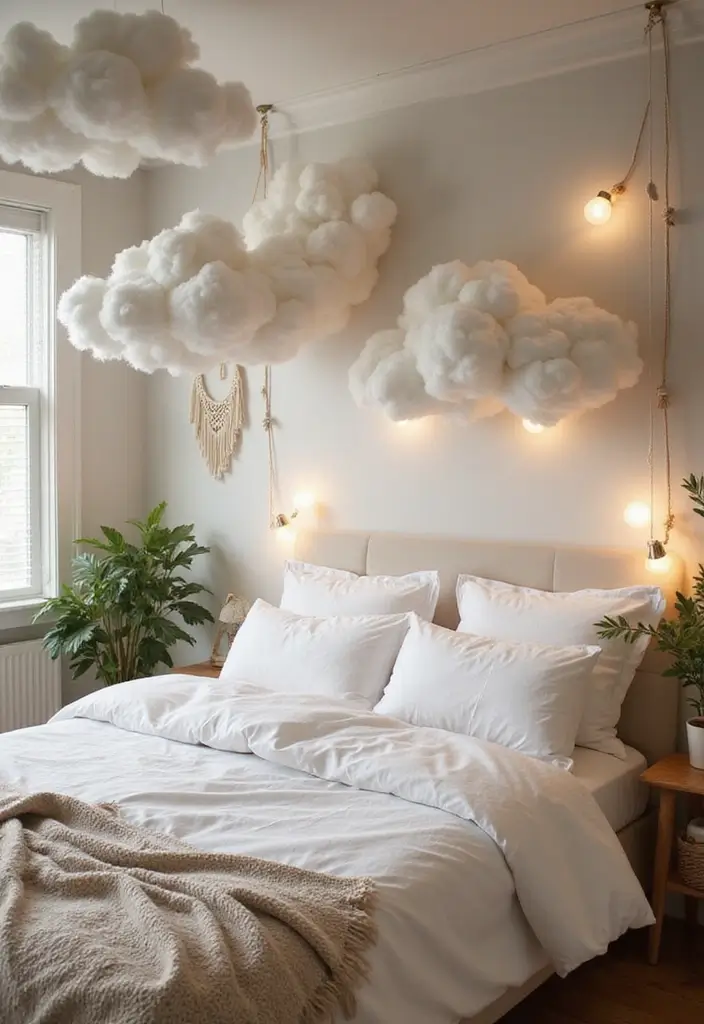
If you want a ceiling that feels light and dreamy, fabric clouds are a perfect pick. They bring texture to the room without heavy fixtures. This is a simple DIY ceiling clouds idea that acts as textured ceiling decor you can tackle in a weekend. This can instantly soften a room.
– What to use: Cotton, tulle, or lightweight chiffon work best. They stay airy and flexible. Mix a couple of fabrics for more texture.
– How to shape: Cut soft circles or puff shapes. Do three sizes: small, medium, and large. Put them together for a floating skyline.
– Where to place: Group clouds in the center or along a corner. Vary their height so the ceiling feels alive, not flat.
Next steps:
– How to install: Attach fabric strips to the ceiling at different lengths. Let the clouds hang from these strands. Use clear fishing line or thin tape to hide the hardware.
– How to light: Add a soft LED strip behind the fabrics or place tiny lights around the edges. Warm, gentle light makes a calm mood.
– What to watch out for: Don’t use heavy fabrics. Too much weight can pull on the ceiling. Keep the look light and easy to change.
With the right setup, fabric clouds make a room feel quiet and wide. They work in small spaces and bigger rooms alike.
This project is simple to adjust. It fits many ceilings and heights. You can add more or less cloud clusters to match your style. You can also tweak how many clouds you want to get the mood you want.
4. Woven Textile Installations
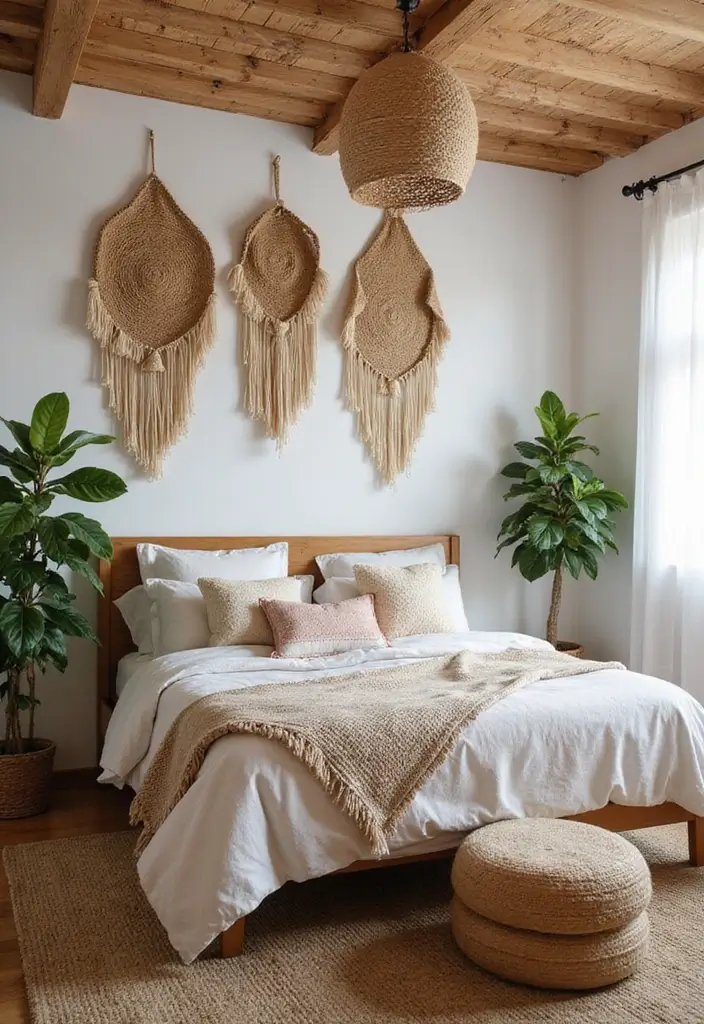
If you want ceiling texture that feels handmade, woven textile installations bring charm. They add warmth to a bedroom.
Choose natural fibers like jute, wool, cotton, or rattan. They age well and stay soft. Pick colors that fit your room and echo your furniture.
– Design idea: make simple shapes. Layer for depth.
– Color tip: stay in a calm palette and echo a shade in the room.
– Function: soft weaves quiet the room by softening echoes.
To install, plan on the floor first. Lay out panels in a balanced layout, then transfer it to the ceiling. Use clear thread and ceiling hooks for a light hold. Start with large pieces near the edges, then add smaller ones toward the center. Keep panels a few inches from the ceiling for air and even light.
This makes the room cozy and rustic. It also softens echoes and creates a focal point.
Care and limits: dust with a soft brush or vacuum on low power. Keep it dry and away from sun to preserve color. It costs more than paint, but less than a full remodel. Plan your budget. If you are unsure, ask a pro to help with mounting.
5. Quilted Fabric Trellis
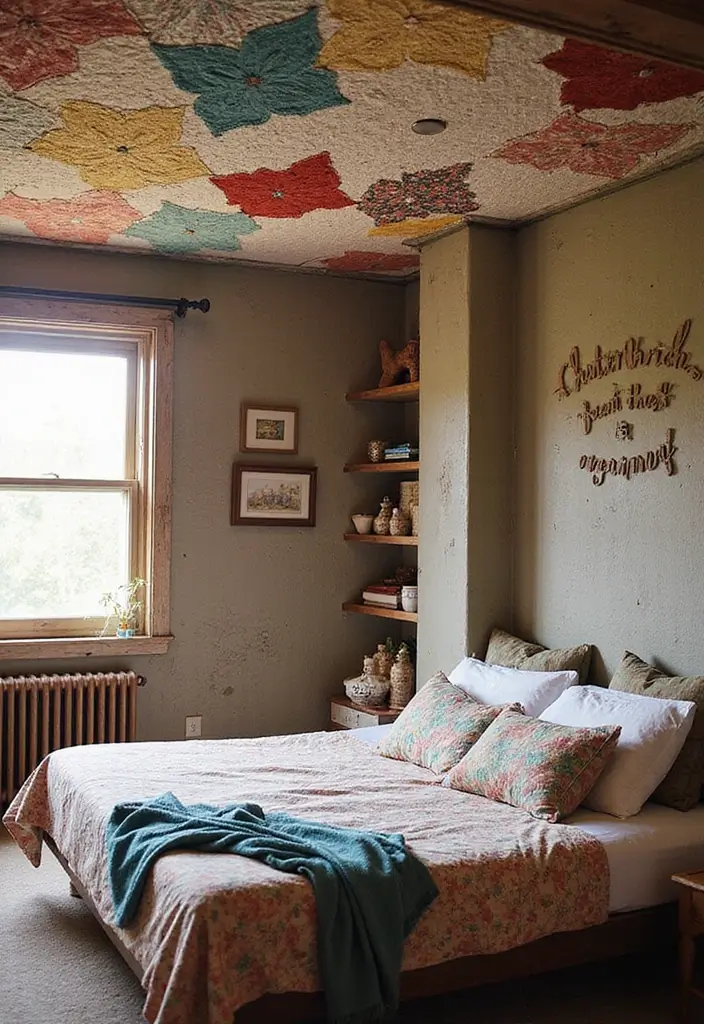
Quilted Fabric Trellis
You want a ceiling that feels warm and alive. A quilted fabric trellis can give you that. It uses small fabric squares pulled into a patchwork that reads as soft texture from below. The result is cozy, with a handmade touch, not loud or busy.
Here is why it works. It adds texture now, and it can tell your story up high. It also helps you recycle old fabrics into a new mood.
This idea lets your room tell a story. Use fabrics from old shirts, scraps from favorite projects, or vintage finds. Mix light and warm tones to keep the room calm. The finished ceiling becomes a quiet focal point.
– Benefits: texture, warmth, and a personal touch.
– Tip: choose fabrics you love that match your nightstands and walls.
– How to install: lay out the patchwork first on a large board or floor. Then add a thin batting behind the fabric to add soft depth. Attach the fabric to the ceiling with a simple method like staples around the edges, or double-sided tape for a gentle hold.
– Final touch: space the squares evenly, and finish with a plain back fabric so the seams stay neat.
This approach works in a cozy bedroom. It makes the ceiling a focal point that feels calm and inviting.
A quilted fabric trellis isn’t just a ceiling; it’s a canvas for your memories. By recycling old fabrics, you weave warmth and stories right above your head!
6. Ethereal Tulle Layers
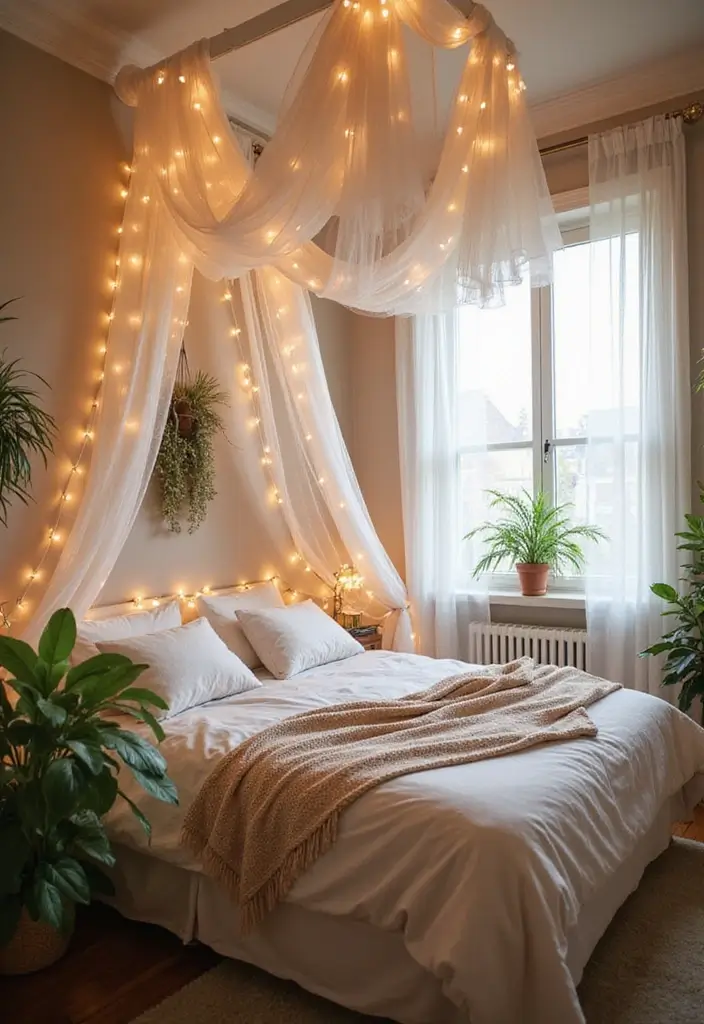
You want a soft, dreamy bedroom ceiling. Ethereal tulle ceiling layers can give you that calm glow. This sheer fabric drapes easy and spreads light softly. Here is why this works: it creates a ceiling canopy that floats above you and diffuses the light for a gentle, even glow.
What you get
– A fabric canopy that seems to float
– Gentle texture that adds depth without crowding the room
– Diffused light that stays warm and flattering
How to do it
– Measure your space. Plan two to three tulle panels in varying lengths for depth
– Secure with ceiling hooks or a light rod. Let the fabric hang in loose swags for a natural look
– Choose colors in the same family. Pastels like blush or dove work well. A single monochrome look can feel modern
Tips you can use
– Secure the tulle well to avoid sagging. Place hooks about a foot apart for even support
– Layer from ceiling toward the mid wall to create a soft fringe of fabric
– Pair with soft pendant lights. A warm bulb enhances the dreamy feel
Care and upkeep
– Dust gently with a soft brush every couple of months
– If needed, pull edges tighter to keep the look neat
Next steps
– Pick your color mood
– Gather hooks, rods, and tulle
– Hang, adjust, and enjoy the airy drama
7. Fabric Map Ceiling

If you love travel, a fabric map ceiling can show it in a simple, stylish way. A ceiling covered in map fabric builds a small story above your head. It adds texture and a bit of drama without overwhelming the room.
Here is how to make it work.
– Choose the map fabric: Pick destinations that matter to you. Pick colors that match your room—soft pastels for a calm look or bold tones for a lively vibe. A light background helps keep the ceiling feeling airy.
– Plan the install: Clean the ceiling first. Use fabric adhesive for easy sticking and removal. Smooth out air pockets with a soft roller so the fabric sits flat.
– Decide on coverage: Do you want the whole ceiling or just framed panels? Framed sections create a neat, gallery feel. Full coverage makes a bold statement.
– Think about color and light: Coordinate the map colors with your bedding and walls. Add layered lighting to highlight the map, like a dimmed overhead light or a wall lamp beside the bed.
– Keep care simple: A soft cloth or feather duster works for dust. Avoid high humidity that could loosen the fabric over time.
– Real-world example: In a sea-toned room, use a vintage map fabric above the bed and frame the corners for texture without glare.
This idea is personal, affordable, and easy to adjust as your travel dreams change.
8. Rustic Burlap Charm

Burlap adds a warm, earthy feel to a room. If your ceiling feels flat, a burlap ceiling can become the room’s quiet hero. It brings texture and a soft, organic look that fits a country or farmhouse style.
– What you get: a natural, tactile surface that casts gentle shadows and makes the room feel snug.
– How to install: stretch burlap across the ceiling using a simple frame of wood or a wire grid. Keep the fabric taut for a smooth finish.
– Quick trick: pair burlap with visible wood beams or trim. That combo boosts the rustic vibe.
– Color and mood: use muted earth tones (warm beige, taupe, sage) to keep things calm and inviting. Choose a lighter burlap for a softer look. Add potted greens or dried stems for a natural touch.
– Maintenance note: burlap can fray. Trim loose threads and seal edges lightly to prevent unraveling.
This look works best in bedrooms with soft lighting and simple furniture. It’s not for every space, so test a small patch first. If you love texture and a cozy feel, this is a practical ceiling idea to try. With the right care, your burlap ceiling stays warm and welcoming.
You can swap lighter or heavier burlap to change shadows.
Worth trying.
9. Vibrant Fabric Swags
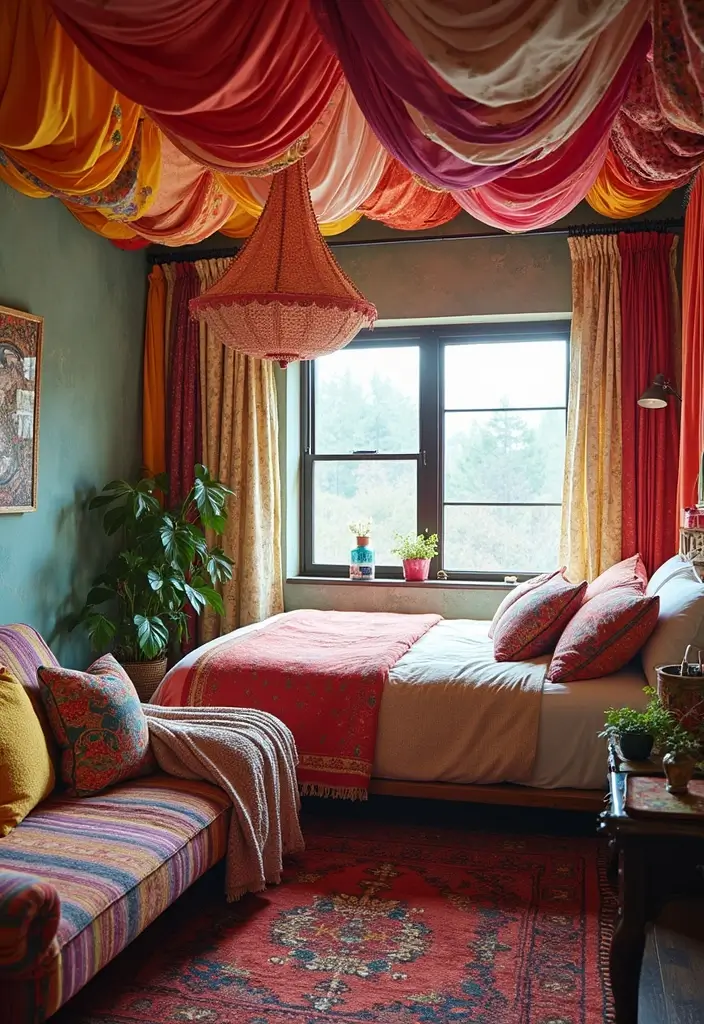
9. Bold Fabric Swags
Here is why this idea works for you. Fabric swags pull the eye toward the ceiling and add texture you can feel. You can pick bright colors or clear patterns that stand out against your walls. The soft folds bring movement to a flat ceiling.
Let’s break it down to make it easy to do:
– Choose a fabric with a strong color or a clear pattern. Think big florals, wide stripes, or a solid that contrasts with your wall hue.
– Pick a fabric type that suits the mood you want. Cotton and linen give a casual vibe, while velvet adds a plush touch.
– Vary the heights of the swags. Clip some sections higher and others lower to create a friendly rhythm across the ceiling.
– Secure the fabric well. Use ceiling hooks or anchors rated for fabric. Keep the edges neat so the folds sit tidy.
Next steps: balance the bold ceiling with softer pieces below. Add a calm rug, simple bedding, and light wall art so the room feels welcoming.
The result is a bright, inviting space that lifts the mood without overpowering the room.
10. Nature-Inspired Fabric Ceiling
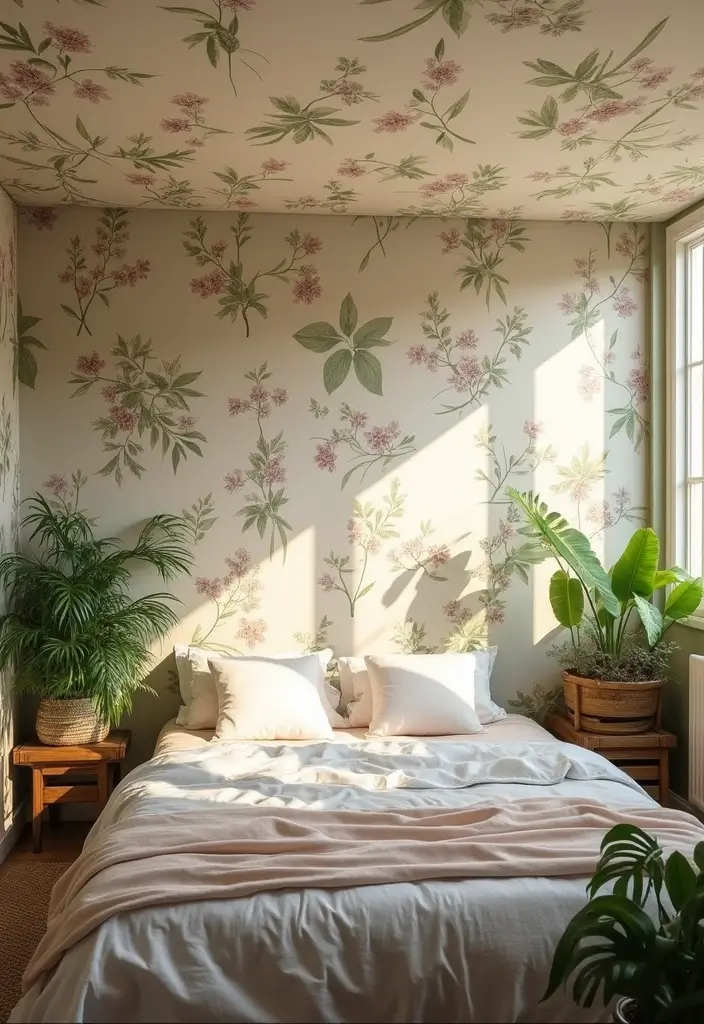
Nature-Inspired Fabric Ceiling
You want a ceiling that adds texture and drama without a lot of work. A nature-inspired fabric ceiling fits that need.
What it is
– Use floral or botanical fabrics as panels or drapes hung from a ceiling track or rods. The fabric covers the ceiling with color and pattern.
Why it helps
– It adds texture that is visible from every angle.
– Here is why it works: texture on the ceiling changes light and adds depth.
– It softens glare and makes the room feel calmer.
– It gives your bedroom a garden retreat mood while staying modern.
How to pick fabric
– Choose floral or leafy prints in cotton, linen, or blends.
– Pick lightweight fabrics for an airy feel.
– Opt for light colors like ivory, soft sage, or pale blue to keep the space open.
How to install
– Measure the ceiling and plan panel sizes.
– Install a track or rod close to the ceiling line.
– Hang panels evenly to create a calm rhythm.
– Layer with sheer fabrics if you want more depth.
Styling tips
– Add greenery around the room, real or artificial.
– Pair the ceiling with natural wood furniture and simple bedding to balance the pattern.
Care and maintenance
– Spot clean stains as soon as you see them.
– Check for sagging and adjust clips or rods as needed.
Next steps
– Start small with four panels in a grid or go full width for a bold feature now, with room to grow.
11. Artistic Fabric Murals

You want a ceiling that feels like a gallery. A fabric mural can give that mood with little mess and no heavy remodel.
Here is why it works. It adds texture and color above your head. It becomes a unique focal point you control.
– Design ideas: Pick a large print that shows a scene or a bold abstract. Choose colors that echo your bedding. A calm scene makes the room feel peaceful; a bright block of color adds drama.
– Materials and methods: Use washable, durable fabric. Heavy cotton, linen, or a canvas panel works well. Prepare the ceiling by cleaning it. Install with fabric glue for a light hold or a staple gun for a solid finish. You can wrap edges around a slim wooden baton for a clean border.
– Step by step: Measure the ceiling. Cut fabric with a few extra inches. Apply glue or staple along the edges while smoothing from the center out. Trim any overhang. Lightly press to remove bubbles.
– Maintenance: Choose fabrics that can be wiped or washed. Dust regularly. If a panel wears, swap it out without redoing the whole ceiling.
– Tips: Match mural colors to your bedding and rug. Align seams with ceiling beams or lights for a tidy look.
Next steps: gather supplies, test a small panel, then hang the full mural.
12. Layered Fabric Cascades

Layered Fabric Cascades
Are you chasing texture and drama on your ceiling? Layered fabric cascades add depth without heavy work. You hang several fabrics in colors that work together, and they fall in soft sheets like a gentle waterfall.
Here is why it works: the layers catch light at different angles and give your room dimension. They move with you, making the ceiling feel alive.
Here’s what you need to start:
– Lightweight fabrics: cotton, linen, or sheer blends. Add a touch of velvet for depth.
– Simple hardware: ceiling hooks or a curved curtain rod system.
– Easy fasteners: clips or ties to keep edges neat.
Let’s break it down. How to install:
– Plan the layout with three to four panels at varied lengths.
– Measure from the ceiling to each panel’s drop.
– Attach anchors, then hang each fabric layer.
– Space the drops so they sit at different heights for depth.
Tips to keep it balanced:
– Stick to a calm color family and mix textures, not loud patterns.
– Start with two layers; add a third only if you want more drama.
Next steps. Ready to test this look in your bedroom? Start with two fabrics and a simple rod, then add a third layer if you love the result.
Transform your bedroom with layered fabric cascades – a simple way to add texture and drama. Let colors flow like a gentle waterfall and watch your ceiling come to life!
13. Canvas Artwork Ceiling
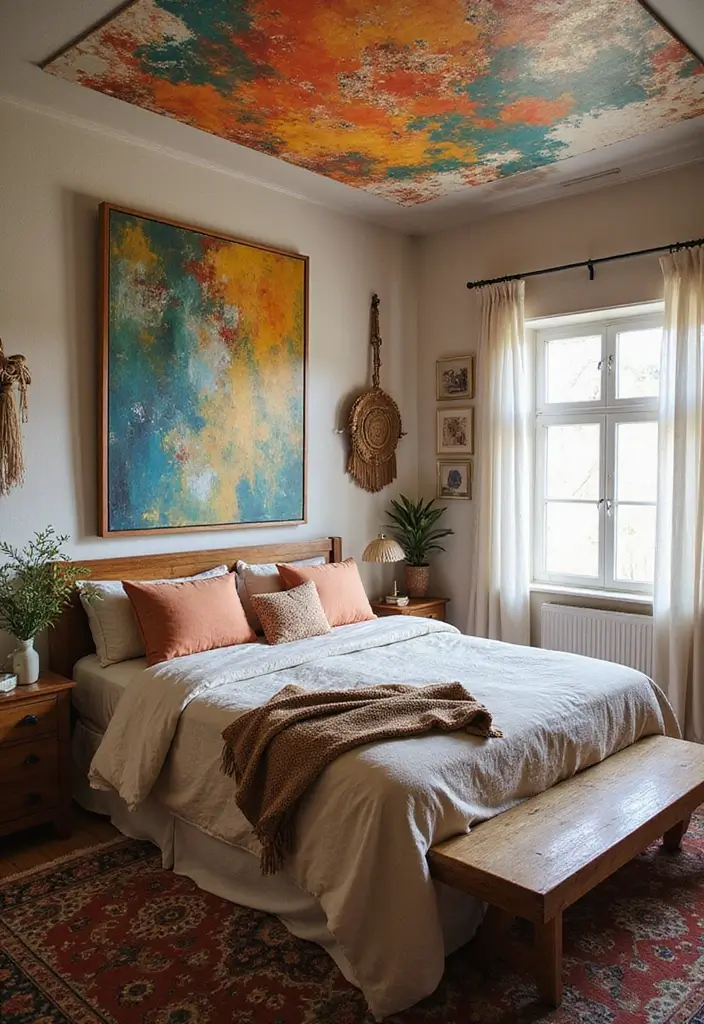
Want a ceiling that feels like a small art gallery? A canvas artwork ceiling can give you that. You move from plain white to a space that shows your taste every night.
How it works
– You stretch canvas fabric or a printed canvas across the ceiling.
– It can show your favorite photo, a pattern, or a printed scene.
– You can buy a ready-to-stretch canvas.
– You can have a custom print made on fabric and then stretch it to fit your ceiling.
Why it helps
– It adds texture and depth without adding bulky furniture.
– It creates a warm focal point that ties your room colors together.
– It makes the space feel personal and inviting.
Choosing the right canvas
– Pick colors that match your bedding and walls.
– Choose a design that fits the room size. Light tones work well in small spaces; bolder art can suit larger rooms.
– Think about light. Control glare with window placement or dimmable lights.
Tips to install
– Tip: If you DIY, paint on the fabric with fabric paints for a one‑of‑a‑kind piece.
– Ensure the fabric is pulled tight and smooth. A sagging center kills the look.
Next steps
– Measure the ceiling, pick your art, and plan the mounting. A pro can help with brackets or safe adhesive if needed.
Transform your plain ceiling into a stunning canvas! A fabric ceiling idea bedroom can turn your space into a cozy art gallery, showcasing your personal style every night.
14. Color-blocked Fabric Panels
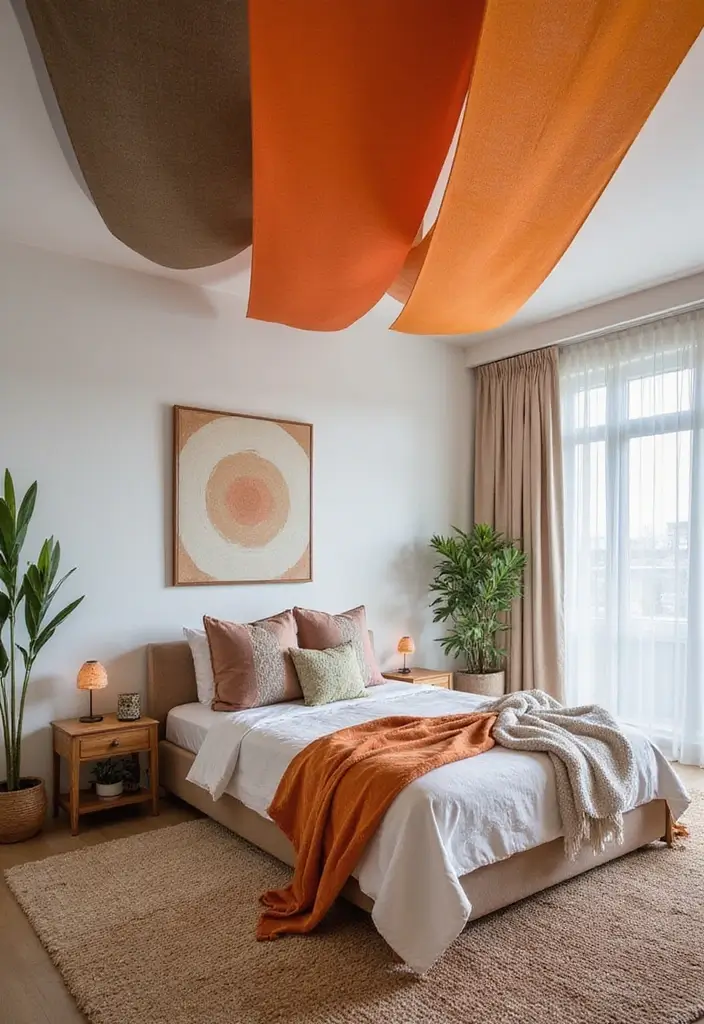
Looking for a ceiling that feels fresh and modern? Color-blocked fabric panels give you a bold look without clutter. You can mix solid colors to create a clean, layered effect that still reads calm from the floor. This works well in minimalist rooms where texture adds interest. Here is why this works: color blocks shape light and mood.
– What to pick
– Choose 2 or 3 solid colors that tie into your walls or decor.
– Keep the fabric texture the same across all panels.
– Use non-patterned fabrics for a crisp, contemporary finish.
– Plan the layout
– Decide panel sizes. Narrow bands feel sleek; larger blocks feel dramatic.
– Sketch a quick grid on the ceiling so you can see the rhythm before you cut.
– Install tips
– Use a light backing like foam board behind each fabric panel to keep shape.
– Attach the panels with removable strips or a slim ceiling track. This lets you adjust or remove them later.
– Choose matte fabrics to avoid glare under lights.
– Care and limits
– Dust regularly with a soft cloth. Vacuum gently if needed.
– Avoid direct sun to prevent fading. Rotate colors slowly if you have strong light.
Next steps: try this on a small area first, then expand.
15. Vintage Lace Overlay
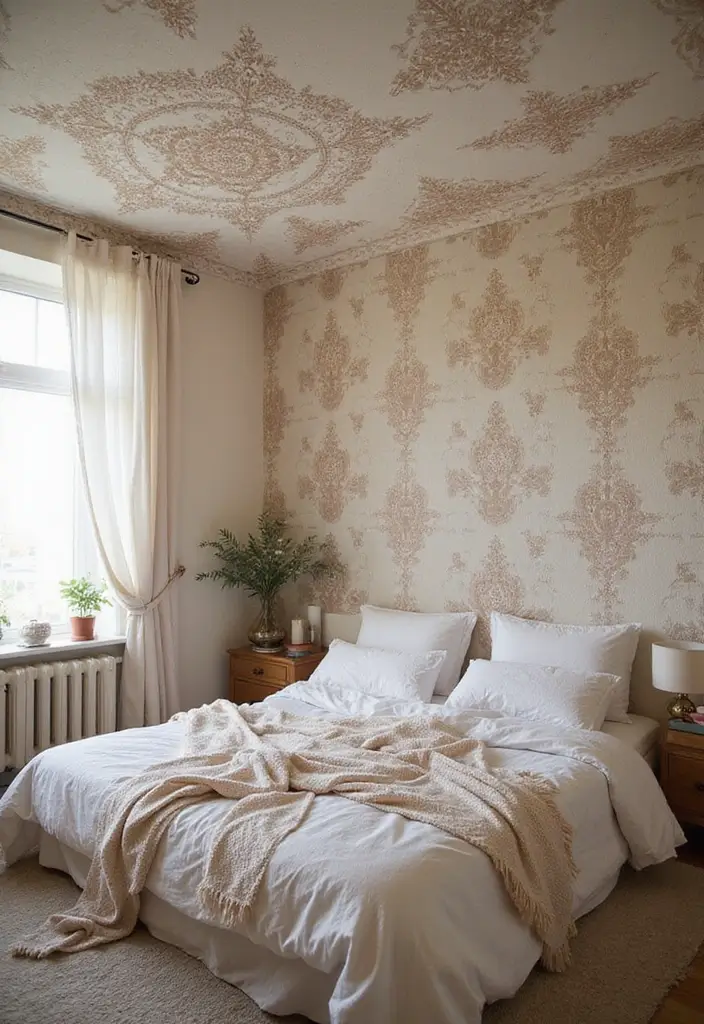
If you want texture and a touch of romance on your ceiling, try a vintage lace overlay. Lace catches light and adds a soft, delicate pattern that plain ceilings miss. You’ll notice tiny shadows that make the room feel warmer and calmer.
This idea fits classic, feminine looks and also pairs nicely with boho decor. It can soften sharp angles and bring a cozy, dreamy vibe to your bedroom.
– Tip: Layer lace over another fabric for added depth and complexity.
– Consideration: Make sure the fabric is lightweight to avoid sagging in the middle.
How to get the look simply
– Choose a lace with a gentle pattern and a pale color that echoes your room.
– Drape the lace loosely so it billows softly, then trim to fit the ceiling edges.
– Attach with removable clips or light pins so you can swap ideas later without damage.
Practical notes
– A lace ceiling creates a calm, intimate mood that screen time can’t match.
– Keep dust low by using a light cleaning with a feather duster or a soft vacuum brush.
– If you live in a sunny space, pick lace that won’t fade quickly and consider a pale backing for better light diffusion.
Next steps: if you want texture, drama, and a vintage vibe, a lace ceiling is a simple, stylish move.
16. Velvet Ceiling Panels
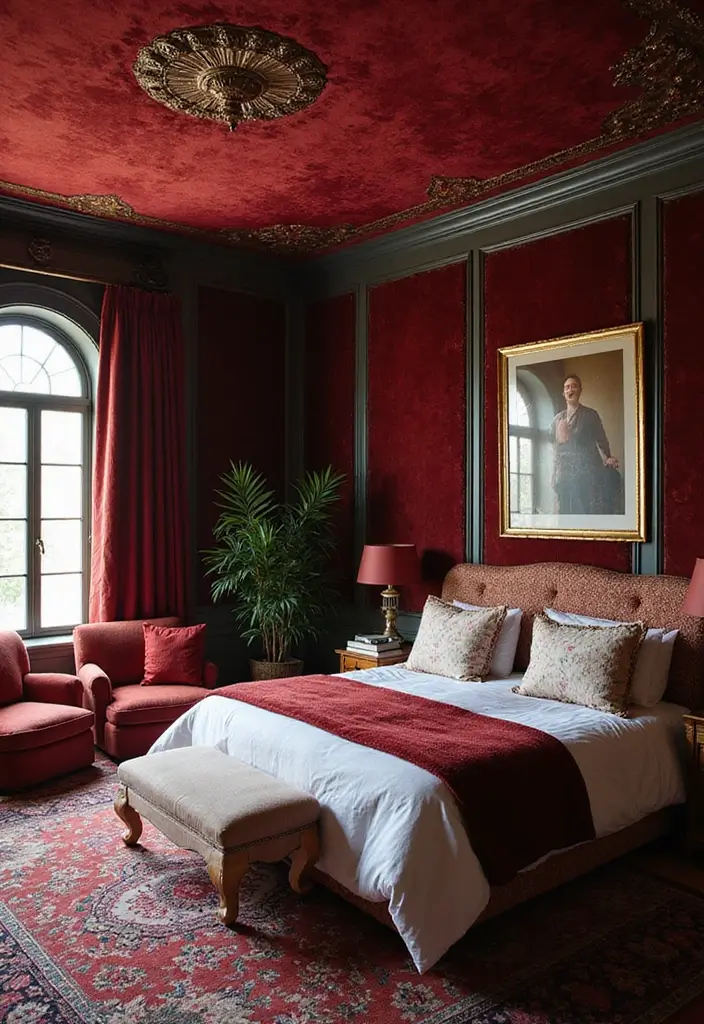
Velvet Ceiling Panels offer a stylish way to add texture and warmth to your bedroom ceiling. They bring depth that makes the room feel snug and inviting. Choose jewel tones like emerald, sapphire, or deep burgundy for a rich, cozy vibe. Lighter shades can work, but dark colors heighten the drama and amp the intimate mood.
– Installation: Use adhesive velvet panels for a smooth finish. Start with clean, dry ceiling surfaces. Measure carefully, cut panels to fit, and press them firmly so the adhesive bonds well.
– Style trick: Pair velvet with metallic accents. Gold or brass fixtures catch light and add a touch of glam. A slim pendant or small chandelier can lift the ceiling without overpowering the space.
– Boho boost: This finish shines in a bohemian room. Layer with woven textures, wood tones, and leafy plants to balance softness with edge.
– Care and upkeep: Velvet rewards gentle care. Keep the room dry and well ventilated. Dust with a soft cloth, and follow fabric care labels for any cleaning.
– Considerations: Velvet ceilings can feel heavy in small or low rooms. Start with a small panel area to test the look and budget. Check ceiling height and choose light, flexible adhesive options if needed.
– Quick mood lift: Add warm lighting with dimmable bulbs to enhance the cozy glow.
Next steps: start with a small patch to feel how it changes the room.
17. Felt Art Installations
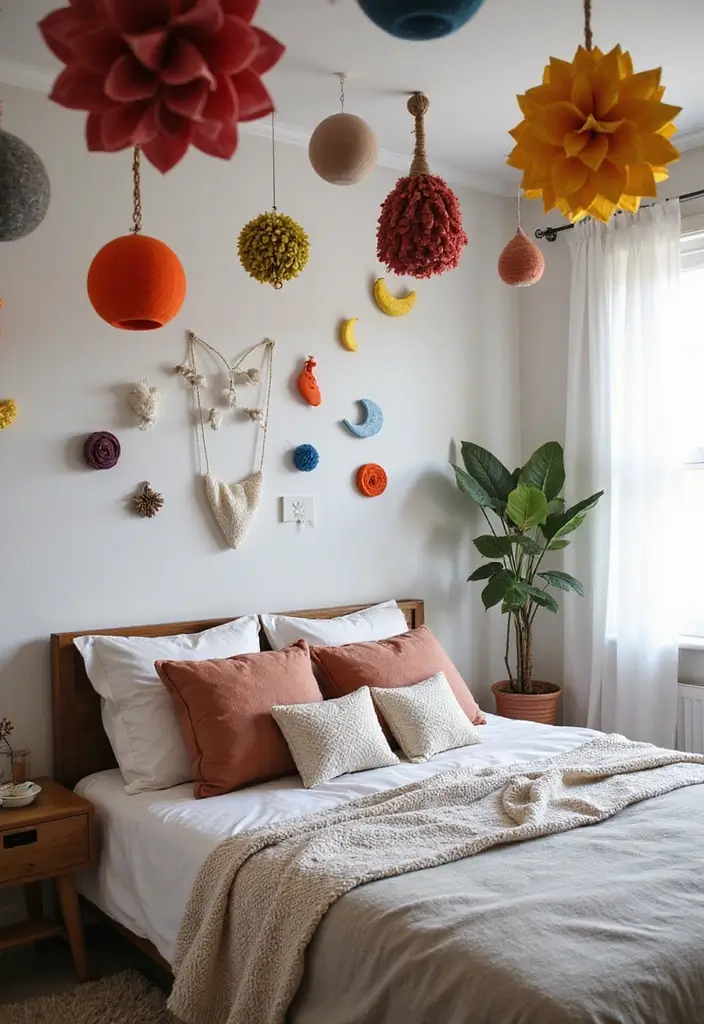
You want a ceiling that adds texture and mood to your bedroom. Felt art installations on the ceiling can do that with a soft touch and warm colors. Felt lets you shape pieces into leaves, moons, or waves. You can show your style without a big project.
This works for a DIY plan. Felt is lightweight and affordable. You can swap pieces later if you want a new look.
– Materials to start — Pick wool felt for a squishy, drapey feel or acrylic felt for bright, flat color. Have a few colors on hand, about 3 to 5 tones, to mix and match.
\n\n- Design ideas — Create a field of small shapes like leaves drifting across the ceiling. Try a thin band of shapes along the center. Add a soft cloud cluster for a calm vibe.
\n\n- Mounting methods — Map your layout with light chalk or painter tape first. Cut the shapes, then attach with glue dots, removable strips, or safe pins. Test one piece to check the weight and hold.
\n\n- Safety and care — Keep heavy bits away from edges. If you rent, ask the landlord before the install. Check pieces after a week to confirm they stay secure.
\n\n- Care and upkeep — Dust gently with a soft brush. Avoid soaking or heavy cleaning on felt, so colors stay true.
\n\n
18. Fabric Streamers for a Fun Vibe
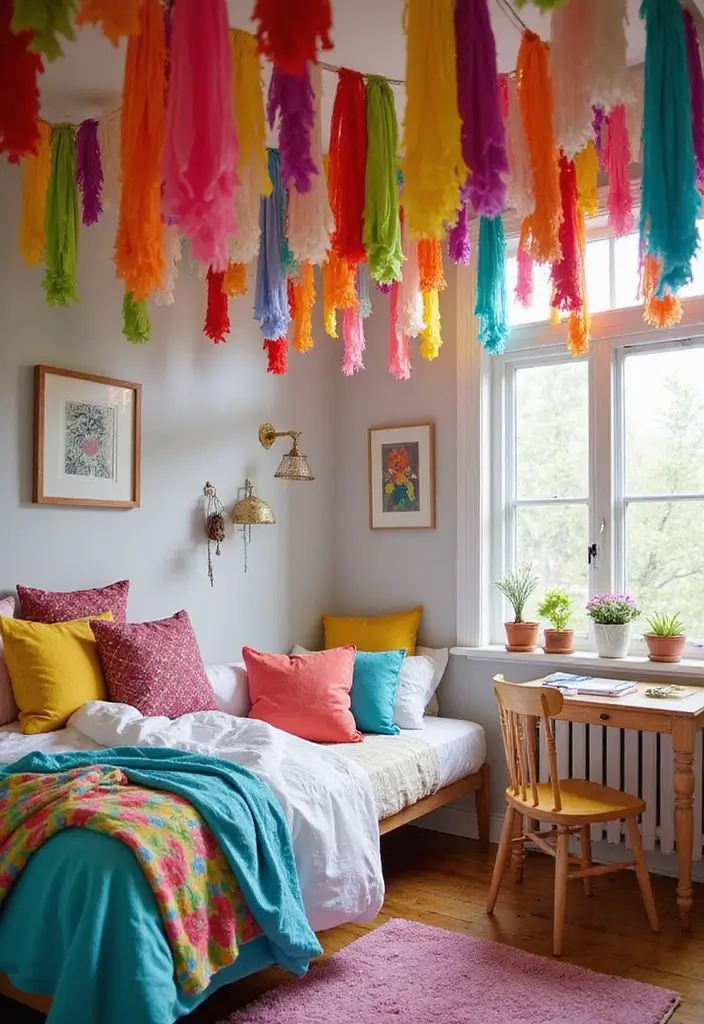
Here is why fabric streamers work in a bedroom. They add texture. They move with the air. They make the ceiling feel higher. They create a cozy mood. You can choose colors and patterns that fit your mood.
What you need
– fabric strips in your chosen colors and patterns
– ceiling hooks or sticky strips
– scissors, a ruler, and a bit of string for spacing
How to install
1) Pick a spot on the ceiling where light hits gently.
2) Cut long strips that you can handle easily.
3) Attach the top of each strip to a hook or strip. Let the fabric hang down in varied lengths.
4) Step back and adjust so some pieces sweep past the bed and others near the lamp.
Design ideas
– Mix solids with printed fabrics. A few calm tones plus one brighter stripe work well.
– Let some strips be longer for a cascading effect.
– Change colors with the season to keep the room feeling fresh.
– This idea fits a kid’s room or a craft space. It puts a light, playful vibe in any corner.
– Experiment with different heights until the mix feels balanced.
Care and safety
– Make sure hooks are secure before you walk under them.
– Use lightweight fabrics to keep weight low.
– Dust the fibers occasionally with a soft cloth.
– If you have a ceiling fan, keep streamers clear of the blades.
Next steps
Now you know how to do it. Gather supplies, plan a quick setup, and enjoy the new texture on your ceiling.
Transform your bedroom with fabric streamers! They add texture, create movement, and make your space feel cozy and inviting. A simple touch can elevate your fabric ceiling ideas bedroom to new heights!
19. Sheer Fabric Canopy
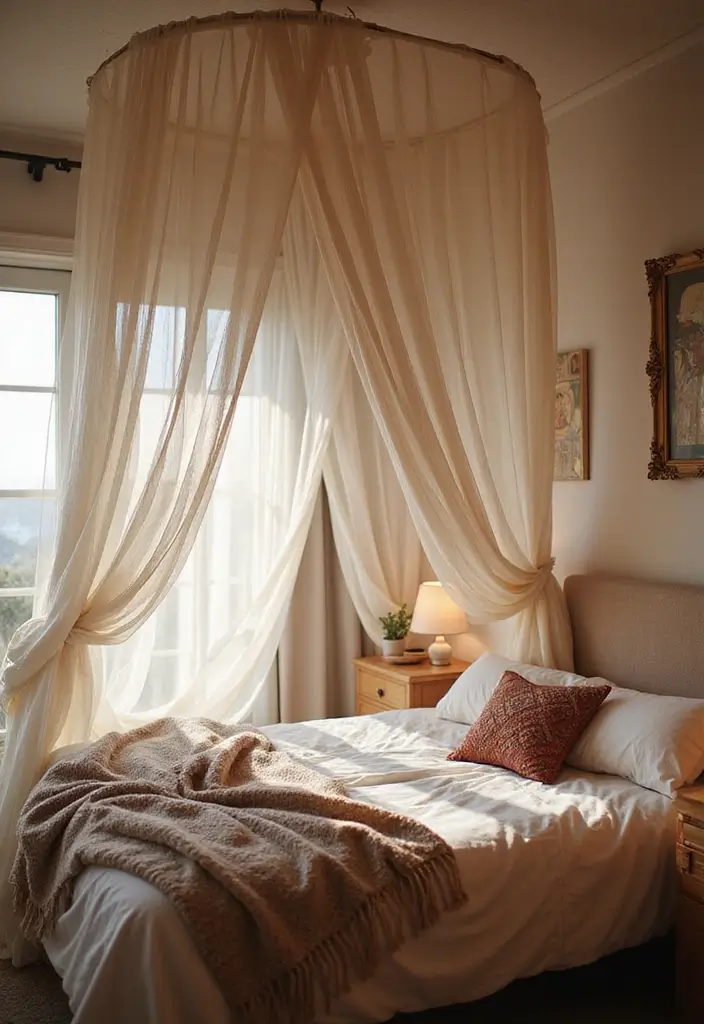
A sheer fabric canopy adds a soft, dreamy layer above your bed. You get privacy without dulling the room’s light. You also gain texture that makes the ceiling feel closer and the room cozier.
Here is why this works: lightweight fabrics float in the air and create gentle movement when you move. Choose voile, chiffon, or light cotton for a breezy look. Pick colors like white, ivory, or pale blush to keep the space airy.
Next steps to install:
– Measure your ceiling height and bed width.
– Attach small ceiling hooks or a tension rod at the points you want the canopy to start.
– Drape the fabric and secure it so it hangs softly with a gentle pool on the floor.
Design tips you can try:
– Let the canopy frame the bed and leave space around the sides for airflow.
– Add warm lighting under the fabric or string fairy lights to boost the glow.
– Keep the fabric clean with a quick shake or gentle vacuum.
Safety and care:
– Make sure all fasteners are secure before sleeping.
– Opt for washable fabric or a fabric you can spot clean.
Next steps: pick a fabric, install a simple frame, and enjoy a room that feels larger and more intimate.
20. Colorful Patchwork Ceiling

Color on the ceiling wakes a room. If you crave warmth, a colorful patchwork ceiling can be your answer. It turns the ceiling into a work of art you live under.
Here is why it works:
– It adds texture and depth.
– It brings warmth and personality.
– It fits boho style when you mix patterns.
Let’s break it down.
– Palette: choose 4 to 6 colors that echo your walls and rug. Keep some in the same family to avoid chaos.
– Fabrics: use cotton, linen, and even silk for different feels. Lightweight fabrics help the ceiling stay comfortable.
– Layout: spread swatches on the floor first. Move them around until the mix feels balanced.
– Backing and install: attach a thin backing board or sturdy craft panels to the ceiling. Then staple or glue the fabrics in place. Use a light touch so you can remove or adjust later.
– Care: pick washable fabrics where you can. Dust with a soft cloth. Avoid moisture.
– Lighting: warm LED lights behind the patchwork bring colors to life. It makes the room feel cozier.
Next steps: measure your ceiling, gather swatches, and test a small corner first. A well done patchwork ceiling adds texture and a calm buzz to any bedroom.
21. Soft Draped Fabric Roof
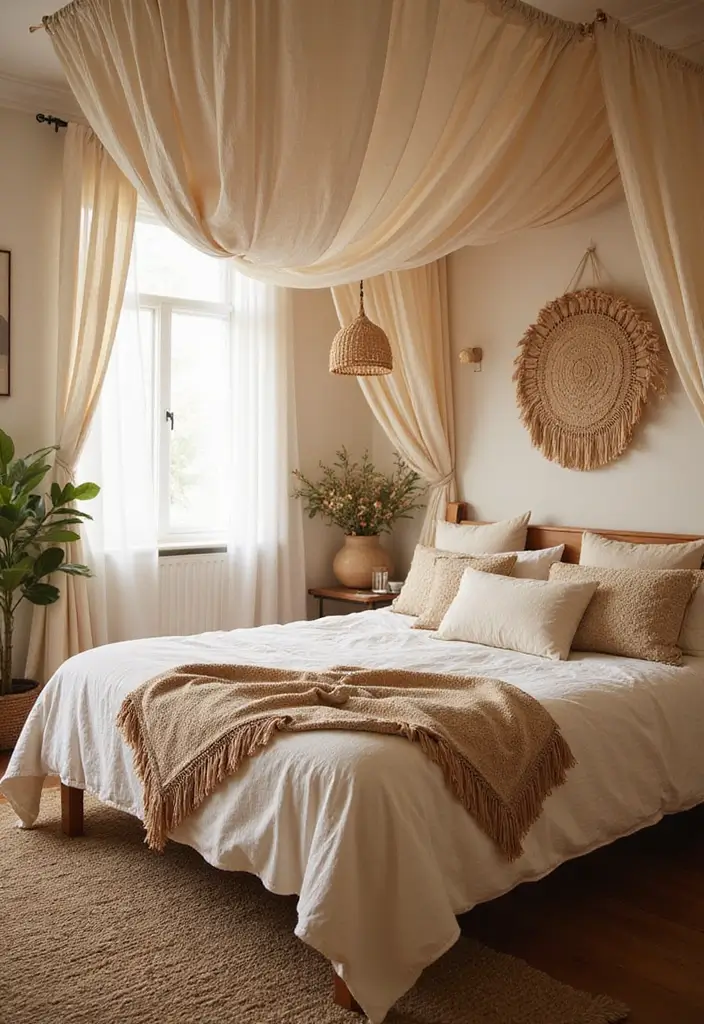
If your bedroom feels flat or loud at night, a soft draped fabric roof can bring warmth and drama. It creates a cozy cocoon that makes the ceiling part of the design, not just a surface. This fabric ceiling idea works well in small rooms, where a gentle canopy adds intimacy without crowding the space.
Here is why it helps. The folds catch light in new ways, so the room glows softly instead of looking flat. Fabric texture adds depth, making the wall behind it feel farther away. It also softens sound, giving you a calmer, quieter vibe.
Materials and colors to consider.
– Light fabrics like cotton voile, linen, or sheer satin keep the space airy.
– Colors in pale blue, warm cream, or soft blush boost brightness.
– Choose fabric with a slight sheen to bounce lamp or daylight softly.
Installation basics.
– Create a slim frame or use ceiling clips to hold the fabric taut.
– Drape in loose folds, starting at the center and working outward.
– Secure edges with discreet clips; avoid heavy hems that sag.
– Next steps: use a thin liner to protect the fabric and help color stay true.
Lighting and safety tips.
– Add hidden LEDs behind the folds for a gentle halo.
– Pick flame-retardant fabric and follow local safety rules.
– Keep the setup light so cleaning is easy and the look stays fresh.
Maintenance and quick care.
– Dust with a soft cloth, then wipe as needed.
– Vacuum at low power with a brush attachment for dust control.
22. Textured Denim Ceiling
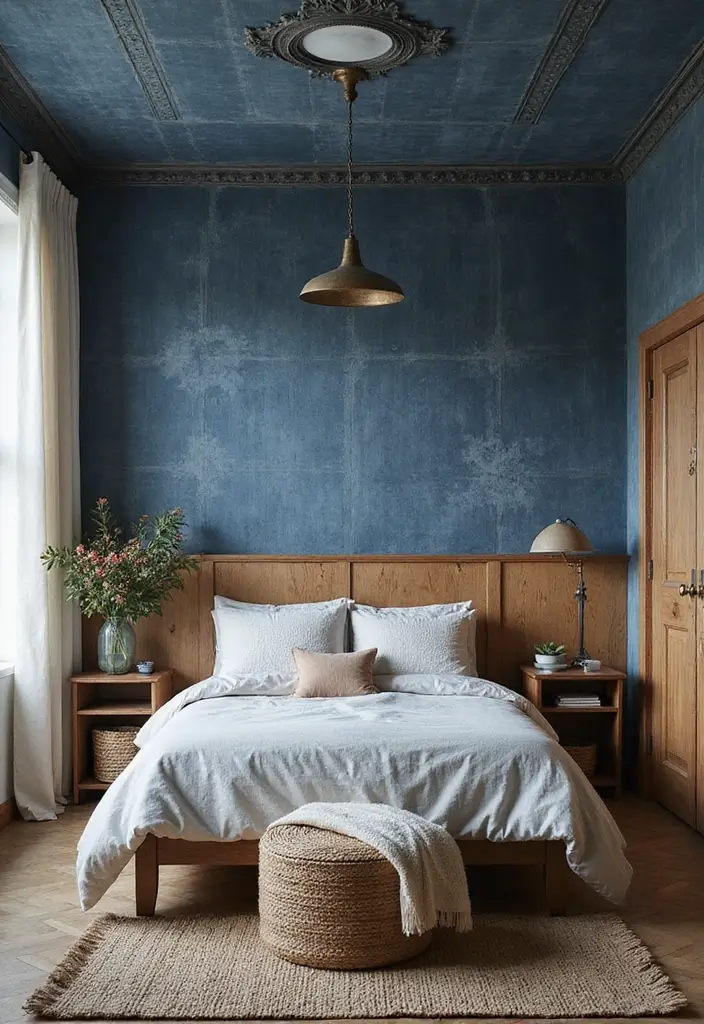
You want a bedroom that feels warm and a bit rugged. A textured denim ceiling can deliver that. It adds real depth and a hand‑made vibe without losing coziness. This look works best in rooms that lean rustic, boho, or casual chic.
Here is why it fits a bedroom. The fabric folds quietly with light, so walls stay calm while the ceiling becomes a subtle focal point. Denim’s natural color range—deep indigo to light blue—stays forgiving and hides small marks. It also helps soften noise, making late nights feel calmer.
– Installation options: You can use denim panels for a clean, even surface. Or try a patchwork approach with denim scraps for a layered, tactile ceiling. If you choose panels, attach them to a lightweight grid or a thin baseboard so they lie flat. For patches, sew patches into large sheets and then staple or glue them in place.
– Tips to get a cohesive look: Pair denim with wood elements like beams, ceiling trim, or wooden furniture. Add warm lighting below to highlight the texture without glare. Keep the rest of the room light and neutral so the denim stays the star.
Next steps: decide your method, pick denim shades that match your palette, and test a small area first. Denim ceilings mix texture with comfort in a way that feels effortless.
– Care and considerations: Denim may fade in strong sun, so use window treatments to protect it. Clean with a soft vacuum or a damp cloth if needed. If the ceiling is high or the space has humidity, consider professional help for a secure install.
23. Geometric Fabric Shapes
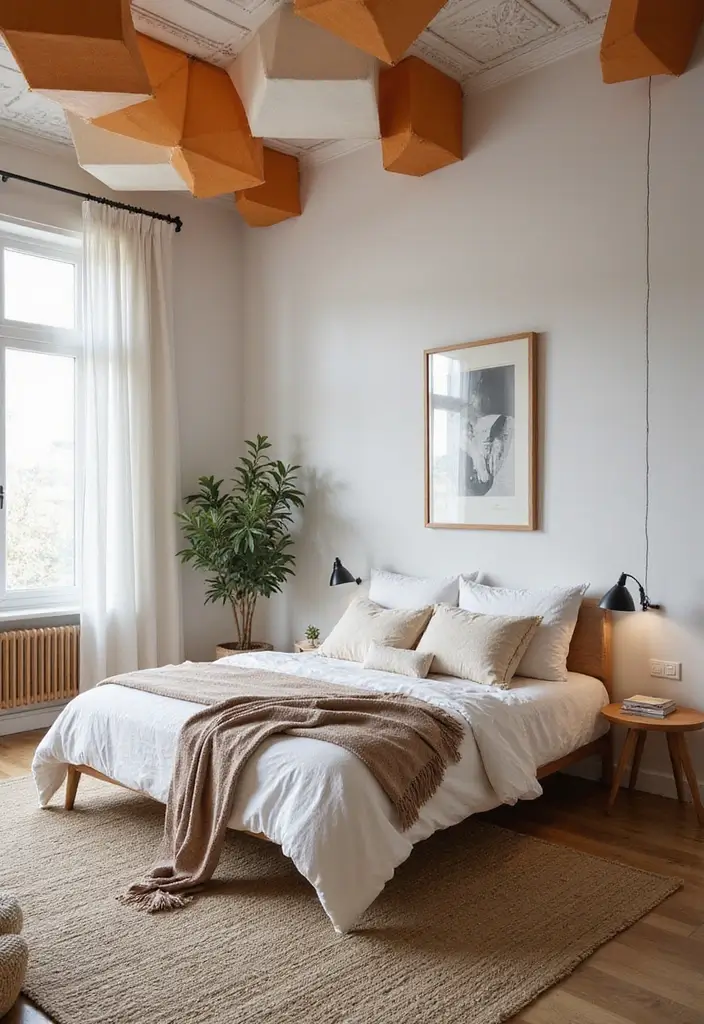
Struggling to add texture to a plain ceiling? Geometric fabric shapes offer a simple, striking solution. You cut fabric into basic forms and arrange them in a pattern that reads as modern and tidy. The result is a ceiling that catches the eye without stealing the scene from your bed or dresser.
Choose a look that fits your room. Bold colors make a statement. Black and white patterns feel timeless and chic. In a minimalist bedroom, these shapes bring character while keeping the rest of the decor calm and uncluttered.
– Materials: pick lightweight fabrics like cotton or felt. Use a thin backing if you want extra stiffness. Have a light adhesive or mounting squares on hand, plus a few clear pins for quick fixes.
– Shape ideas: triangles, circles, hexagons, or diamonds. Mix a couple of shapes for interest, but keep sizes similar to stay balanced.
– Layout options: grid for order, honeycomb for rhythm, or a freeform scatter for a playful vibe.
Here is how you do it. Measure the ceiling and decide your pattern. Cut the shapes with careful, straight lines. Lay them out on a table to check the fit. Attach each piece and adjust as needed.
Tips to keep it steady: secure shapes firmly, but test removal first. Keep gaps even and proportional so the ceiling reads clean rather than busy. Next steps: sketch a quick pattern on paper, pick a color plan, and gather your supplies.
24. Hanging Fabric Bouquets
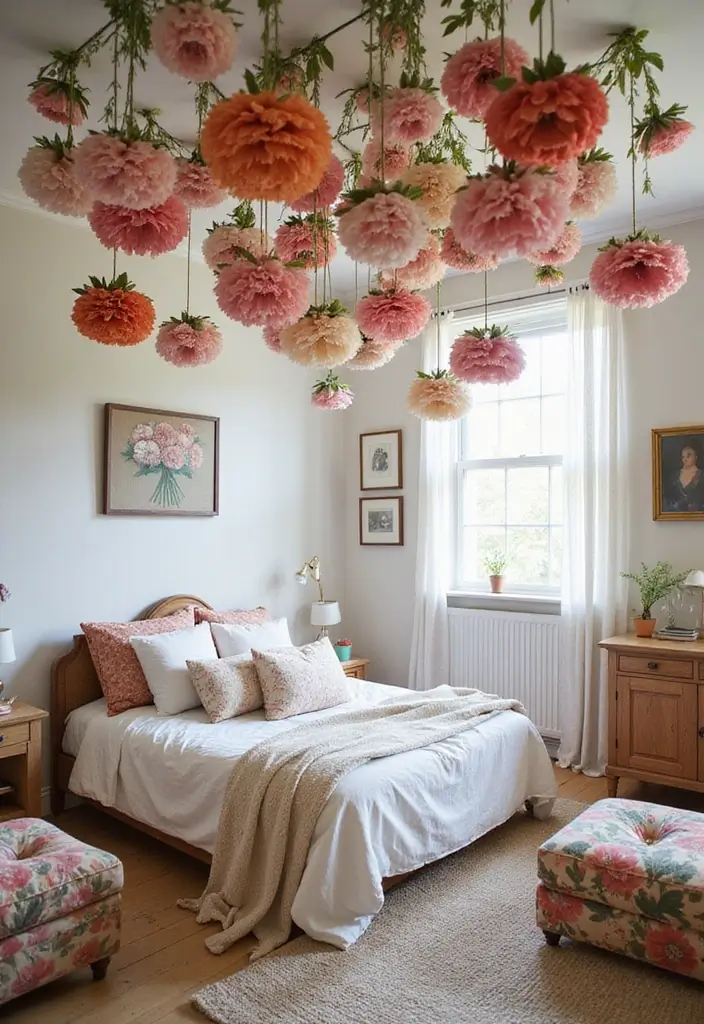
You want a ceiling that adds texture and drama without a big remodel. Hanging fabric bouquets can give you that look. They move with the air and catch light in small, surprising ways.
What they are: clusters of fabric pieces that dangle from the ceiling. They look like soft flowers or tiny bundles. They bring whimsy and personality to any bedroom.
– Materials: light cotton, linen, velvet, or chiffon. Mix textures. Pick colors that fit your palette.
– How to make: gather 3 to 5 fabric pieces. Tie them at the center with string. Leave tails to act as stems. Add a small ring at the top for hanging.
– How to hang: install a sturdy ceiling hook. Attach a short length of clear line. Clip the bouquet to the line. Hang at different heights for depth.
– Safety and care: avoid heavy fabrics that pull on the hook. Check weight and joist support. Dust with a soft brush. Keep away from moisture.
– Styling ideas: group two to four bouquets near the bed or along a wall. Add warm lighting or string lights. Use soft colors for a calm feel.
Next steps: pick fabrics, plan a layout, and test the height before you commit. With a little planning, this ceiling art stays lively and true to your room.
25. Decorative Fabric Banners
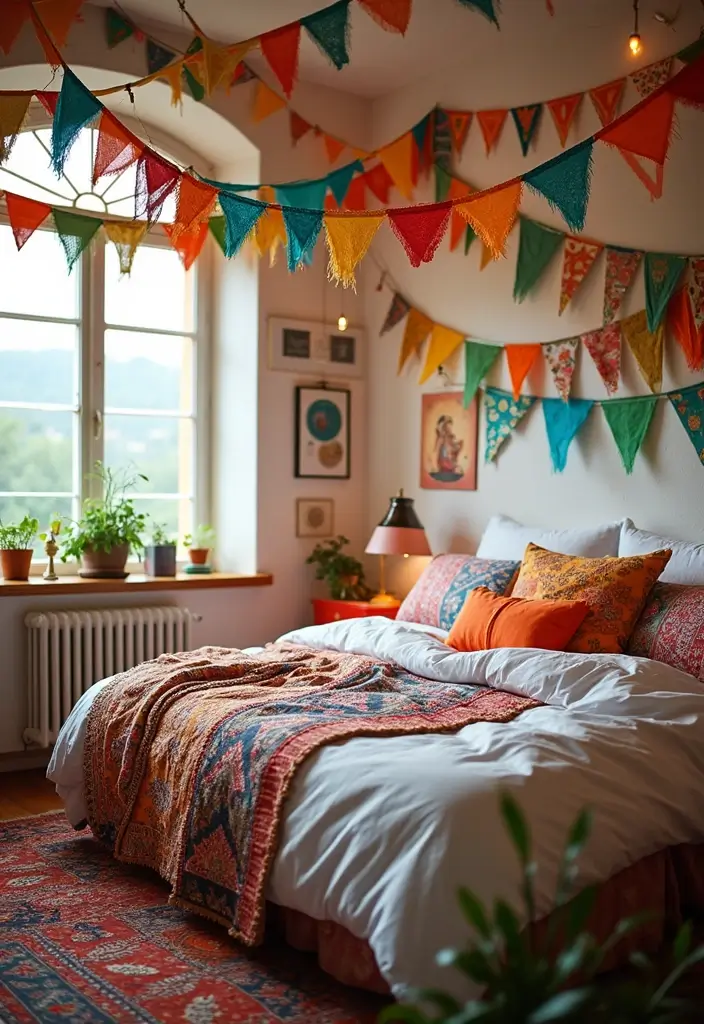
Decorative Fabric Banners on the ceiling can turn a plain room into a cozy space. They add texture and a personal touch without a big redo.
Here is why this idea works. Fabric banners catch light softly and move a little with the air. They create a warm, inviting feel. You control the vibe by mixing patterns or keeping to one tone.
– What you’ll use
– Use banners made from cotton, linen, or velvet.
– Repurpose fabric scraps or buy ready-made fabric banners.
– Add a simple string, ribbon, or twine to hold them.
– Install ceiling hooks or removable adhesive hooks.
– How to make or choose
– Cut fabric into pennants or triangles and hem the edges.
– Space banners evenly on the string.
– Pick a color palette that matches your room.
– How to hang
– Install hooks where you want the banners.
– Run the cord between hooks and hang banners at different lengths.
– Care and tips
– Dust with a soft cloth and keep fabrics dry.
– Check hooks every so often and adjust as needed.
– Next steps
– Plan a layout, gather supplies, and try a trio of banners.
26. Ombre Fabric Ceiling
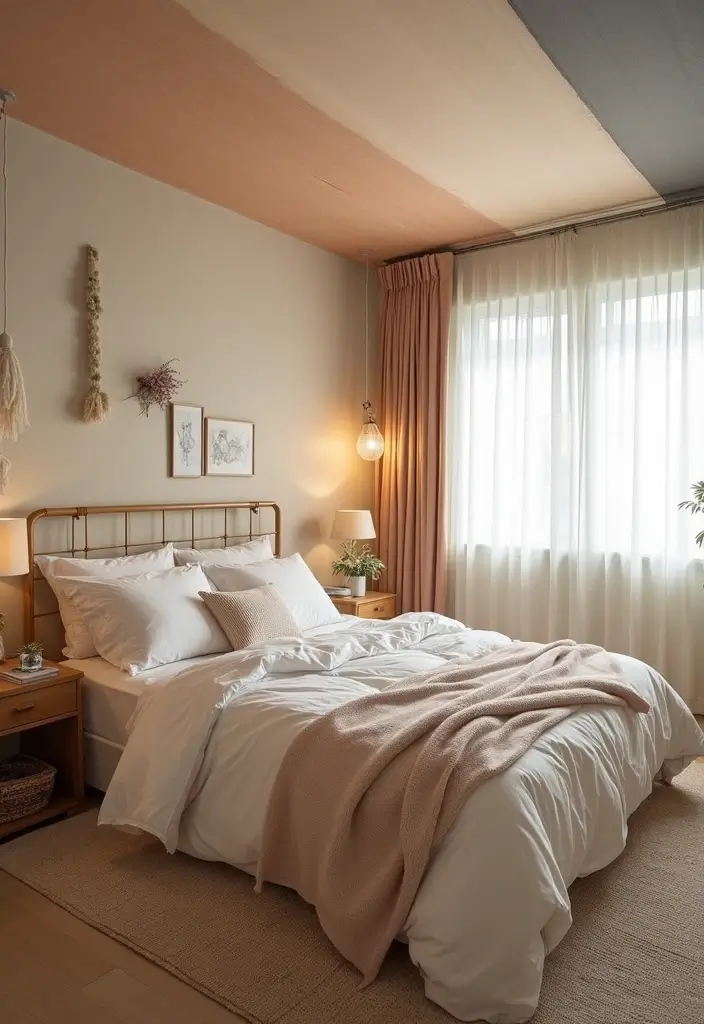
What it is
An ombre fabric ceiling blends colors from light at the edge to darker toward the center. It adds texture and depth without heavy patterns.
Why it works
You get a calm, inviting feel. The eye travels upward and the room seems bigger and warmer.
How to choose fabrics
Pick fabrics in colors that match your decor. Use similar fabric weights so the gradient stays smooth. Start with a light shade on the edge and move to a deeper hue in the middle.
How to create a smooth transition
Plan the panel layout. Sew or attach panels with clean seams. For a seamless look, use small gradient steps between colors.
Lighting and mood
Add soft lighting behind the ceiling to glow through the fabric. Keep wall color neutral so the ombre shines.
Practical steps
– Measure the ceiling to know how much fabric you need
– Buy panels in the chosen color palette
– Attach using lightweight frames or gentle adhesive strips
– Trim to fit exact edges
Tips and cautions
Avoid busy patterns that distract from the gradient. Check the color shift from several angles for a smooth feel.
Maintenance
Dust gently with a microfiber cloth every few weeks.
Next steps
Choose your colors, grab swatches, and test a small patch before a full install.
27. Lattice Fabric Framework
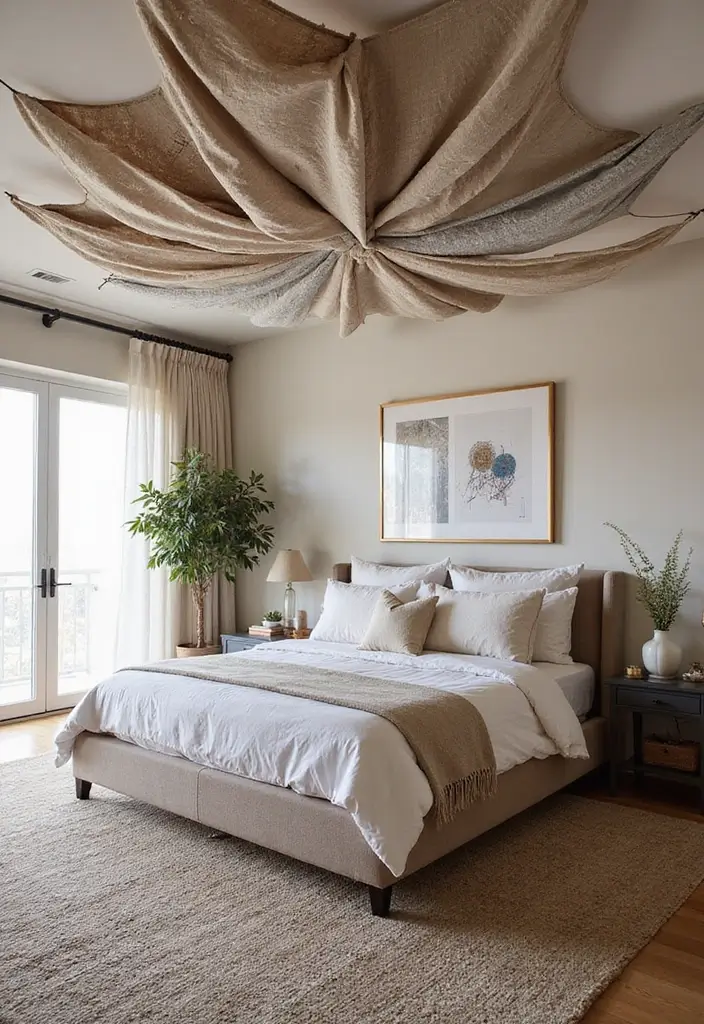
You want a ceiling that adds texture and drama without shouting. A lattice fabric framework gives you a modern, refined look. It creates a crisscross pattern of fabric strips that catches the light and adds depth. You can mix colors and textures to fit your bed and walls.
– Plan the grid: measure the ceiling and sketch a simple lattice that fits your room.
– Choose fabrics: pick light and dark tones to create a calm contrast.
– Cut the strips: trim fabric pieces to the width you want.
– Build support: install a thin frame or corner lattice to hold the fabric.
– Attach and weave: lay or weave the strips across the grid and secure at every joint.
Here is why it works. It adds texture and warmth to your bedroom. The grid catches light and helps the ceiling feel higher. The pattern becomes a quiet focal point you can reuse in other decor.
Keep the finish clean by keeping lines straight. Secure the fabric well to prevent sagging.
– Style ideas: Pair linen for an airy vibe, or go velvet for a moody look. Try neutral tones or a bold contrast to suit your space.
– Maintenance: Dust with a soft brush. Check fasteners occasionally and tighten as needed.
28. Layered Fabric Stencils
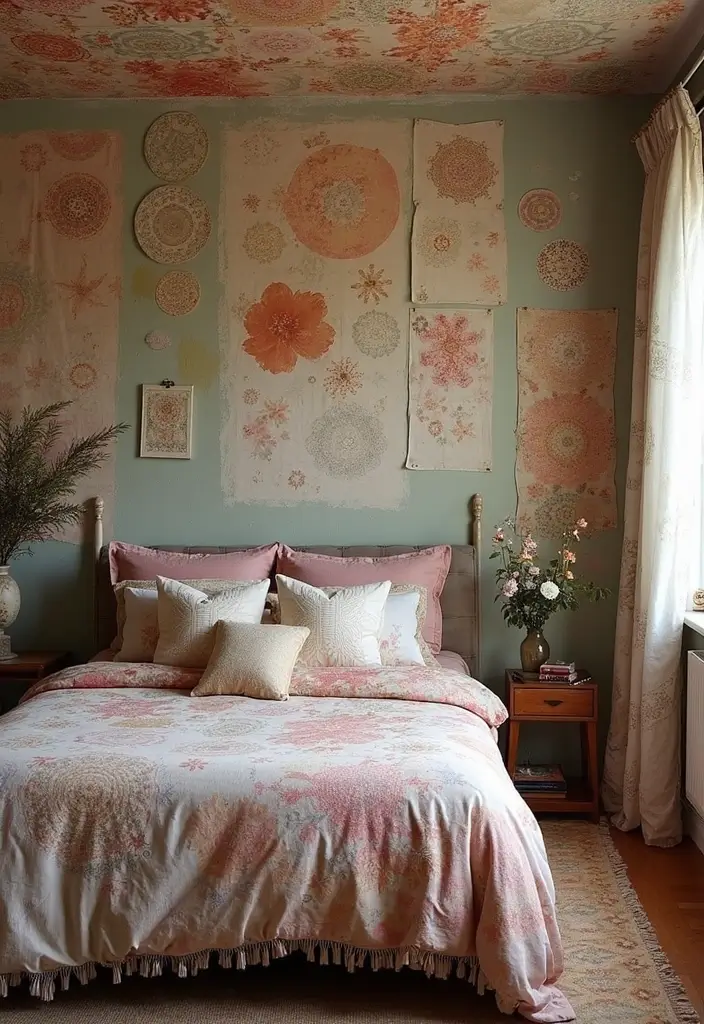
You want a ceiling that feels cozy and dramatic, but you don’t want to paint it. Layered fabric stencils give texture and depth with light and shadow. It’s a simple, flexible idea you can tailor to your bedroom.
Here is how to do it.
– Step 1: Plan your look. Pick a motif that fits your bedroom vibe, like leaves, swirls, or geometric shapes.
– Step 2: Choose fabrics you can cut easily. Felt and cotton work well and stay neat as you work.
– Step 3: Create a paper template. Draw the pattern, then cut it out. This keeps your shapes clean.
– Step 4: Cut your fabric layers. Cut the base layer first, then extra shapes for the stacked effect.
– Step 5: Attach and test. Use light, removable glue dots or painter’s tape. Hold each piece in place, turn on the lights, and look from different angles.
– Step 6: Fine tune. You can switch colors, add a few extra layers, or space shapes differently to change the drama.
Next steps: Test a small patch on the ceiling before tackling the whole area. Keep the room well lit at night to see how shadows fall.
The result feels handcrafted and intimate. Layered fabric stencils add texture, turning your ceiling into a warm, tactile feature.
29. Cheery Fabric Tent
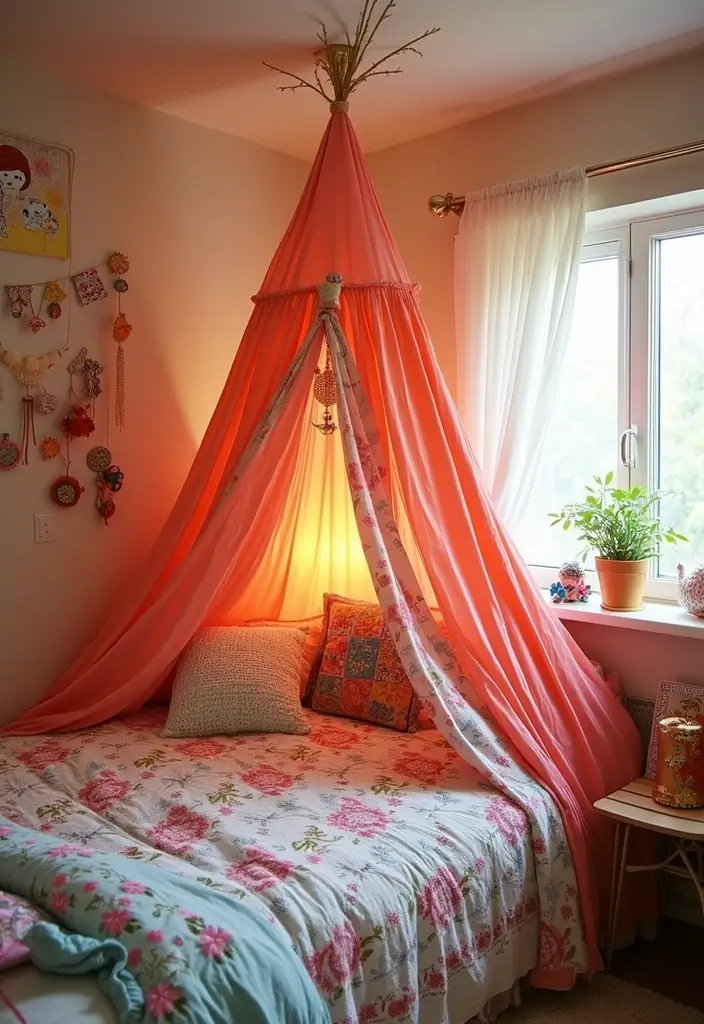
You want a playful ceiling feature that adds texture without a big remodel. A cheery fabric tent does that with color and whimsy.
Here is why it works: this option shines in a kid’s room, yet it fits any space that needs a bright moment. A fabric tent hangs from the ceiling to frame a cozy nook.
How to pick fabrics: choose bright colors and friendly patterns. Mix stripes with dots or florals to keep things lively. Use lightweight, easy care fabrics like cotton. Make sure the fabric is washable and drapey. Tip: look for fabrics that stay colorful after washing.
Next steps to install:
– Step 1: Decide the size and shape that fits your bed or reading corner.
– Step 2: Pick a lightweight frame, hoop, or ceiling anchors that suit your ceiling type.
– Step 3: Drape the fabric, secure the edges, and check that it sits evenly.
Care and safety:
– Use sturdy anchors and keep cords away from sleeping areas.
– Dust with a soft cloth and spot clean when needed.
If your ceiling is low, trim the fabric a bit so it does not brush your head. Experiment gradually by trying a small sample first. Adjust colors and patterns until the tent feels part of the room.
30. Twisted Fabric Ropes
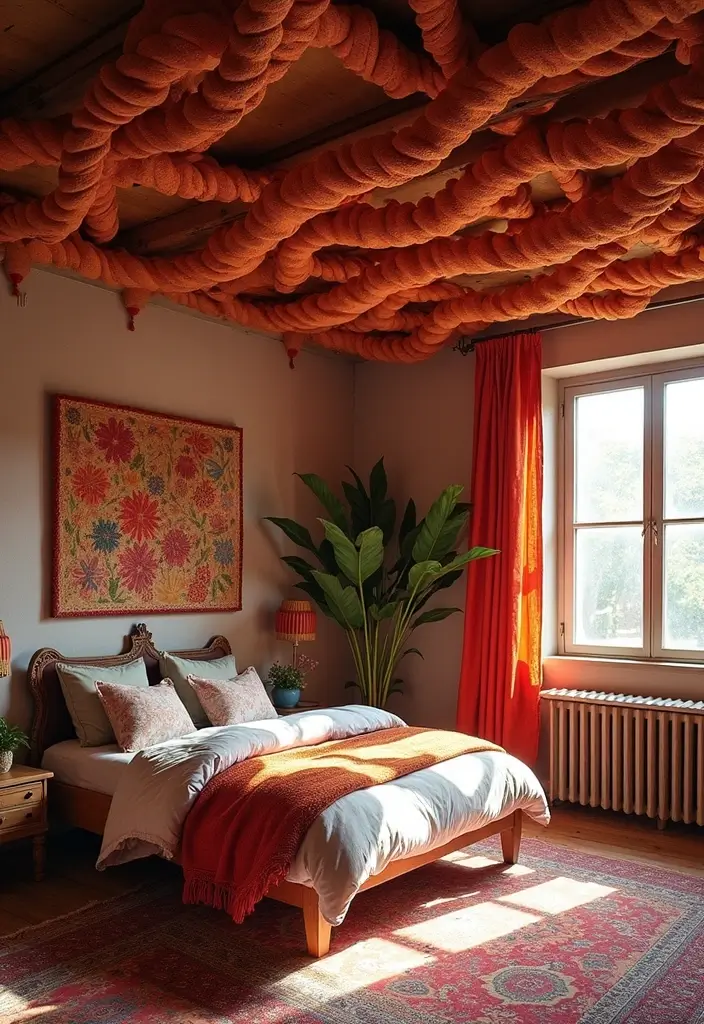
Looking for a ceiling detail that adds texture without loud decor? Twisted fabric ropes can do it. They add depth and movement, and you can shape them into spirals or waves. Here is why this idea works for a bedroom.
Materials
– Thick fabric ropes in two colors for contrast.
– Ceiling anchors rated for the rope weight.
– Sturdy hooks or screws that fit your ceiling.
– A stud finder and pencil to mark spots.
– Zip ties to tidy ends after you finish.
Layout and planning
– Map your design with painter’s tape on the ceiling.
– Decide between spirals or gentle waves for your space.
Let’s break it down.
Installation steps
– Anchor points go into joists or rated anchors.
– Attach the rope with a secure hook.
– Twist and drape to form spirals or curves.
– Space the ropes evenly to avoid crowding.
Styling tips
– Use high contrast colors to make the ropes pop.
– Keep ends neat with small ties.
– Position the design to suit the bed view.
Safety and maintenance
– Check anchors every few months for looseness.
– Wipe the ropes with a damp cloth and dry.
Next steps
– Try a small sample first on the ceiling.
– Take photos to track how the look grows.
Conclusion
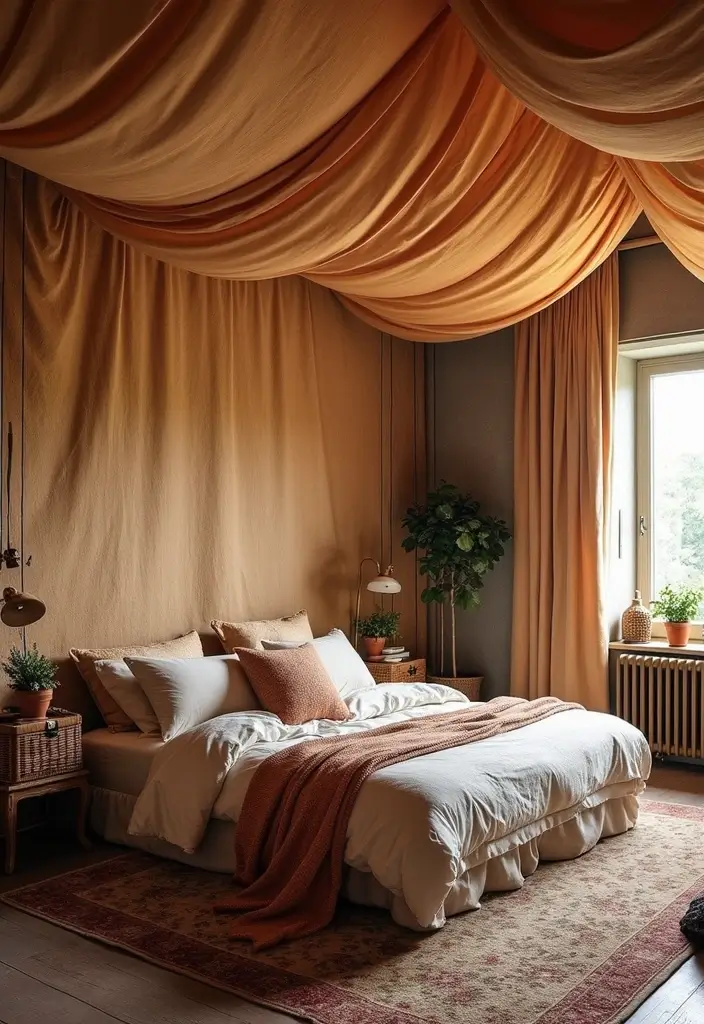
Transforming your bedroom ceiling with fabric design can truly enhance the atmosphere of your space. These 30 fabric ceiling ideas not only add texture and drama but also reflect your personal style, making your room a cozy sanctuary.
Which idea are you most excited to try out? Each option offers a unique way to elevate your bedroom and inspire comfort and creativity!
Frequently Asked Questions
What Are Some Popular Fabric Ceiling Ideas for Bedrooms?
There are numerous creative and stunning fabric ceiling ideas to enhance your bedroom’s ambiance! Some popular options include dreamy canopy drapes that create a soft, private retreat, and bold fabric panels that add vibrant texture and dimension. For a whimsical touch, consider textured fabric clouds or hanging fabric bouquets that bring movement and charm to your ceiling.
How Can I Choose the Right Fabric for My Ceiling?
Choosing the right fabric for your ceiling depends on the mood you want to create! For a cozy and warm atmosphere, opt for natural fibers like wool or cotton. If you’re looking for drama, velvet or bold prints can make a statement. Consider the amount of light in your room; lighter fabrics can soften the glow, while darker hues can add depth and richness to your space. Always ensure the fabric is suitable for ceiling applications!
Are Fabric Ceilings Difficult to Install?
The complexity of installing a fabric ceiling varies based on the design you choose. Simple options like fabric swags or decorative banners can be easily DIYed, while more elaborate designs, such as layered fabric cascades or woven textile installations, might require more skill and planning. Regardless, with the right tools and instructions, many fabric ceiling ideas can be achievable for the average homeowner!
What Benefits Do Fabric Ceilings Offer Over Traditional Ceilings?
Fabric ceilings offer unique benefits that traditional ceilings simply can’t match! They provide texture and warmth, transforming a flat, sterile space into a cozy and inviting environment. Fabric can also help with sound absorption, creating a quieter atmosphere, and it can soften harsh lighting, producing a gentle glow. Plus, you can easily update your fabric ceiling with new styles or colors to refresh your bedroom’s look without a complete renovation!
Can Fabric Ceilings Work in Any Bedroom Style?
Absolutely! Fabric ceilings can complement a wide range of bedroom styles, from bohemian to modern aesthetics. For a bohemian flair, consider draping light fabrics or using patterned textiles. In a modern space, sleek fabric panels or geometric shapes can create a chic vibe. The versatility of fabric allows you to customize your ceiling to reflect your personal style and enhance the overall design of your bedroom!
Related Topics
fabric ceiling ideas
cozy bedroom design
textured ceiling designs
bohemian decor
dramatic fabric installations
creative ceiling decor
vintage lace
easy DIY
nature-inspired design
bold fabric panels
warm textiles
soft lighting

